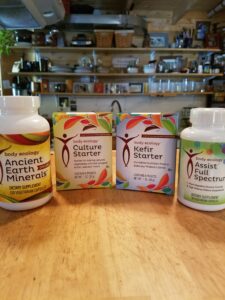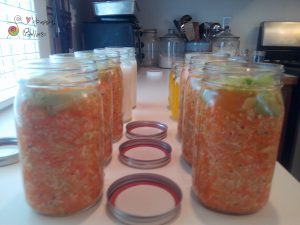Inner Ecosystem: A Living World Inside You
Tara Carpenter, NC.
Nutrition Consultant specialized in helping people regain natural gut microbiome after yeast, bacteria, or viral infections.
 Originally published on November 2, 2014.
Originally published on November 2, 2014.
Like earth, the human body has an inner ecosystem made up of a diverse world of microflora – beneficial bacteria, friendly yeast, commensal viruses – living inside the digestive tract of each and every living being including fish, birds, insects and humans where they work day and night to keep us healthy and in a state of homeostasis (a.k.a. balance).
The inner ecosystem stretches from mouth to rectum and is approximately 30 feet long; neatly packed in this space are millions of micro-flora organisms, both good (probiotics) and bad (pathogens), intermingling in a delicate balance of harmony.

Photo Credit: Buddha Doodles
The good flora help keep bad flora “in-check” with a 10:1 ratio of good flora to bad flora. If the bad flora have the opportunity to overtake the good flora then they can quickly establish higher rank and you might find yourself struggling to heal a yeast, bacterial, or viral overgrowth.
This can happen if YOU (the host of these microorganisms) experience prolonged stress, indulge in processed sugar/refined food, take antibiotics, swim in chlorinated pools, receive a vaccination, take “the pill”, or become pregnant. Many women find themselves with a vaginal yeast infection after being sexual with a partner with oral or penile thrush. All these examples can cause a disruption in the overall balance of the inner ecosystem.
Interestingly, an imbalanced inner ecosystem can also cause food intolerances to crop up because of an enzyme deficiency and/or immune reaction. In fact, the gut and immune system are so closely linked that some say the relationship is so strong we are married to our gut microbes.”

Heal your inner ecosystem with ‘body ecology‘ products.
How Bad Flora Overtake Good Flora
Bad flora love alcohol, sugar, hydrogenated oils, refined flour, drugs of any kind, adrenaline (stress), estrogen, chlorinate, corticosteroids, antibiotics, birth control pills, and anything else that creates an acidic environment for them to live in. When bad flora have these ‘foods’ at their disposal, they breed quickly and build colonies the size of New York City!
YOU are in control here. As the host, you can shut them down effectively by stopping the very things that they thrive on. Turn a blind eye and they will happily thrive inside your inner ecosystem for as long as you (the host) “feed” and give them what they want (sugar, drugs, alcohol, etc.).

Cinnamon kisses can combat sugar cravings 🙂
Bad flora produce toxins…
Too much bad flora creates a toxic situation for YOU/the host and a perfectly ideal one for bad flora. There is nothing better to bad flora (a.k.a. harmful pathogens) than a toxic, acidic environment which to live in and grow a family. If allowed to get to this point then they will next burrow in to your digestive tract lining to establish a population that will naturally produce harmful gases/toxins that can pollute and irritate your digestive tract lining from your mouth down to the anus.
If bad flora build up in the gut lining then this can cause digestive tract tissue to be inflamed, even ‘leaky’. If so then you might feel bloated and develop food sensitivities because the gut and immune system are interconnected (married); if your gut/digestive tract heats with inflammation and gets stimulated then your immune system can kick into high gear and make you susceptible to autoimmune health issues. Hence why simply best to keep this living world of good and bad flora (inner ecosystem) healthy and balanced each day, every meal!

Unsalted Cultured Vegetables are a wonderful addition to meals (and your gut!); a probiotic food is full of hearty diverse forms of good gut flora.
Possible Signs of Imbalanced Inner Ecosystem
- Candidiasis (i.e., vaginal yeast infections, dryness)
- Food sensitivities
- Skin conditions
- Leaky gut
- Bacterial infections (i.e. GBS+)
- Viral infections (i.e. hepatitis)
- Autism
- Digestive disorders (bloating, diarrhea)
Cleanse & Replenish
The best way to keep bad flora in check is to keep your digestive tract balanced. This is the best way to give good flora an upper hand naturally. You are in control of creating this harmony for yourself and your health with the food choices (and food combinations!) you make along with avoiding chlorinated swimming pools and taking antibiotics best you can. Remember, your body is a self-healing living organism always seeking balance so simply give your body the tools to do this job …. if you keep up with your health every day, every meal you will less likely find that a yeast, bacterial, or viral overgrowth roots in.

I help people regain natural gut microbiome after yeast, bacteria, viral infections, please click here for more information about consultations.
Nutritional Support with Tara Carpenter, NC.
One key way to return the inner ecosystem back to equilibrium is to restore good digestion with Body Ecology Diet (B.E.D.); a complete system designed to support the immune system, organs and digestive tract. This dietary protocol starves out bad flora to restore a natural balance to internal chemistry and gut flora by applying key principles that draw on the combined wisdom of ancient and modern medicine and nutrition such as Chinese medicine, Ayurveda, and macrobiotics.
Ways to balance your inner ecosystem…
- Unsalted probiotic-rich food (i.e. milk kefir, cultured vegetables).
- Colonics or enemas on a regular basis.
- Raw apple cider vinegar in the morning.
- Extra-virgin, cold-pressed coconut oil.
- Digestive enzymes and/or probiotic supplements
- Body Ecology Diet (B.E.D.)

References
Campbell-McBride, N. MD. (2011). Gut and Psychology Syndrome. Soham, Cambridge; Medinform Publishing
Gates, D. (2010). The Body Ecology Diet. Bogart, GA: B.E.D. Publications
This blog post contains affiliate links, you can read here to learn more.
Disclaimer: This content is general information only; primarily educational in nature; and not to be treated as a substitute for medical advice of your doctor that you, the reader, may require for any cause whatsoever, now or in future. Consult medical doctor regarding any health problem(s) and keep him/her fully informed to the opinions, ideas, and dietary advice offered on this site that you find useful.
May all bellies be happy!

